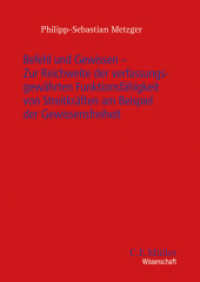- ホーム
- > 洋書
- > 英文書
- > Business / Economics
Full Description
This book looks at the distribution of income and wealth and the effects that this has on the macroeconomy, and vice versa. Is a more equal distribution of income beneficial or harmful for macroeconomic growth, and how does the distribution of wealth evolve in a market economy? Taking stock of results and methods developed in the context of the 1990s revival of growth theory, the authors focus on capital accumulation and long-run growth. They show how rigorous, optimization-based technical tools can be applied, beyond the representative-agent framework of analysis, to account for realistic market imperfections and for political-economic interactions. The treatment is thorough, yet accessible to students and nonspecialist economists, and it offers specialist readers a wide-ranging and innovative treatment of an increasingly important research field. The book follows a single analytical thread through a series of different growth models, allowing readers to appreciate their structure and crucial assumptions.
This is particularly useful at a time when the literature on income distribution and growth has developed quickly and in several different directions, becoming difficult to overview.
Contents
Introduction ix Part One Aggregate Growth and Individual Savings 1 Chapter One: Production and Distribution ofIncome in a Market Economy 3 1.1 Accounting 4 1.2 The Neoclassical Theory of Distribution 8 Chapter Two: Exogenous Savings Propensities 14 2.1 A Linear Consumption Function 16 2.2 References and Further Issues 25 Chapter Three: Optimal Savings 28 3.1 The Optimal Consumption Path 29 3.2 The Dynamics of Accumulation and Distribution 36 3.3 Welfare Distribution in Complete Markets 41 3.4 References and Further Issues 46 3.5 Appendix:HARA Preferences 47 3.6 Review Exercises 48 Chapter Four: Factor Income Distribution 51 4.1 Factor Shares and Savings in Early Growth Models 53 4.2 Factor Shares in the Neoclassical Growth Model 57 4.3 Optimal Savings and Sustained Growth 63 4.4 Policy and Political Economy 70 4.5 References and Further Issues 77 4.6 Appendix:Factor Shares in a Two-Sector Growth Model 81 Chapter Five: Savings and Distribution with Finite Horizons 88 5.1 Distribution and Growth in the Two-Period OLG Model 90 5.2 Inequality in a Perpetual Youth Model 104 5.3 One-Period Lifetimes and Bequests 115 5.4 References and Further Issues 122 5.5 Appendix:Consumption in the Perpetual Youth Model 124 Chapter Six: Factor Shares and Taxation in the OLG Model 127 6.1 Factor Shares in the Two-Period Model 128 6.2 Factor Shares and Growth in the Perpetual Youth Model 138 6.3 References and Further Issues 143 Part Two: Financial Market Imperfections 145 Chapter Seven: Investment Opportunities and the Allocation ofSavings 147 7.1 Decreasing Returns to Individual Investment 148 7.2 Increasing Returns and Indivisibilities 158 7.3 Endogenous Factor Prices and "Trickle-Down "Growth 165 7.4 References and Further Issues 172 7.5 Review Exercises 177 Chapter Eight: Risk and Financial Markets 180 8.1 Optimization under Uncertainty 181 8.2 Rate-of-Return Risk 189 8.3 Portfolio Choice and Risk Pooling 195 8.4 References and Further Issues 200 8.5 Review Exercise 202 Chapter Nine: Uninsurable Income Shocks 204 9.1 A Two-Period Characterization 205 9.2 General Equilibrium:The CARA Case 210 9.3 General Equilibrium:The CRRA Case 214 9.4 Application:Uninsurable Risk in the Labor Markets 226 9.5 References and Further Issues 235 P rt Three Many Goods 239 Chapter Ten: Distribution and Market Power 241 10.1 Growth through Expanding Product Variety 243 10.2 Variable Elasticities of Substitution 252 10.3 Factor Shares,Taxation,and Political Economy 262 10.4 References and Further Issues 264 Chapter Eleven: Indivisible Goods and the Composition of Demand 266 11.1 Income Distribution and Product Diversity 268 11.2 The Introduction of New Products 275 11.3 Inequality and Vertical Product Differentiation 285 11.4 References and Further Issues 298 Chapter Twelve: Hierarchic Preferences 302 12.1 A Basic Framework 303 12.2 Growth,Distribution,and Structural Change 313 12.3 References and Further Issues 319 Chapter Thirteen: Dynamic Interactions of Demand and Supply 321 13.1 Learning by Doing and Trickle-Down 322 13.2 Demand Composition and Factor Rewards 328 13.3 References and Further Issues 337 Solutions to Exercises 339 References 399 Index 419







